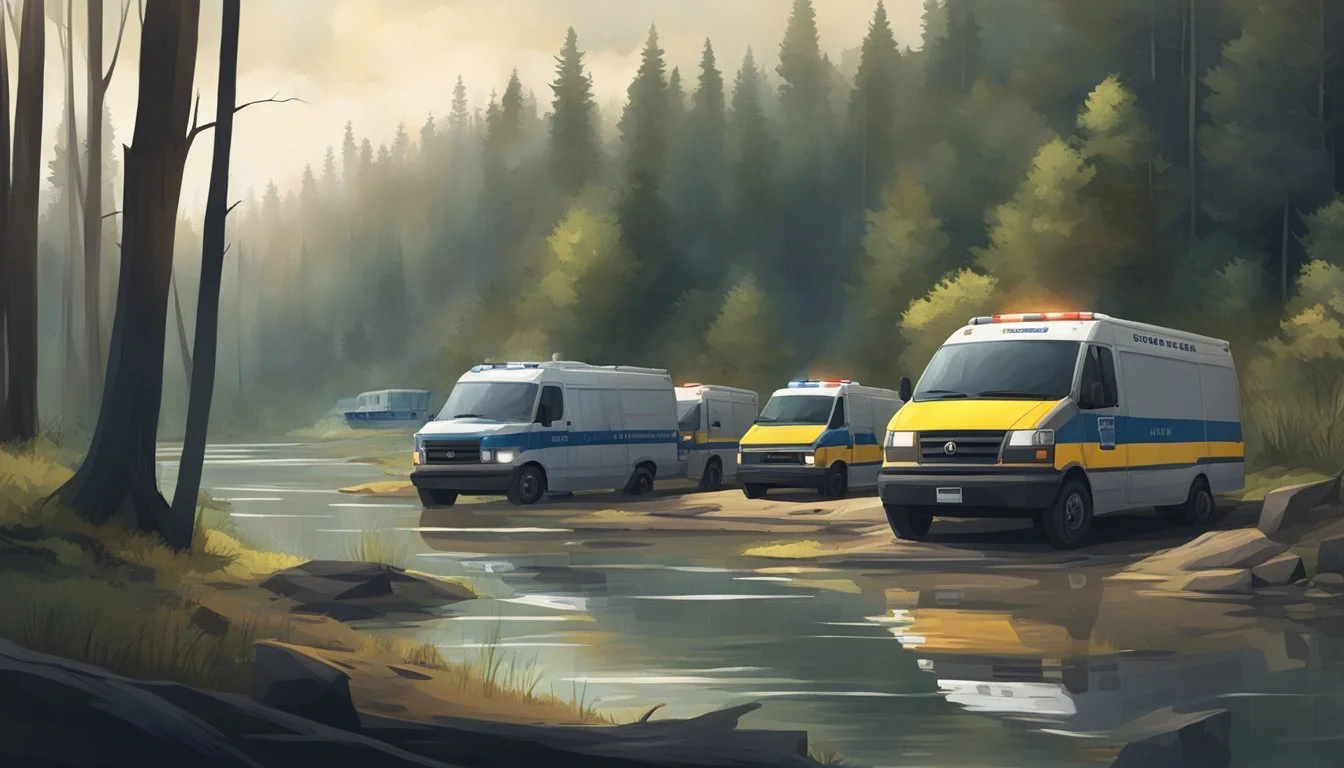Gary Ridgway: 11 Green River Sites That Became Infamous Due to the Killer
Mapping the Trail of Terror
Gary Ridgway, known as the Green River Killer, terrorized Washington state during the 1980s and 1990s. His heinous crimes left a lasting impact on the region, with certain locations becoming infamous due to their connection to his murderous spree. These sites serve as grim reminders of Ridgway's brutal acts and the lives he tragically cut short.
The areas where Ridgway disposed of his victims' bodies range from remote forests to urban riversides. Many of these locations have since become part of true crime lore, drawing attention from investigators, journalists, and the morbidly curious. Understanding the geography of Ridgway's crimes provides insight into his methods and the challenges law enforcement faced in tracking him down.
1) Pacific Highway S
Pacific Highway S, also known as State Route 99, played a significant role in the Green River Killer case. This major north-south highway runs through King County, Washington, connecting Seattle to its southern suburbs.
Gary Ridgway frequently prowled this stretch of road in search of victims. Many of the women he targeted were sex workers who operated along Pacific Highway S.
The area became notorious due to its association with Ridgway's crimes. Law enforcement conducted extensive searches along the highway and its surrounding areas during their investigation.
Several victims' remains were discovered near Pacific Highway S. This led investigators to focus much of their efforts on this corridor.
The highway's proximity to the Green River, where some bodies were found, further cemented its importance in the case. Pacific Highway S became a grim reminder of Ridgway's reign of terror in the region.
2) Meeker Middle School
Meeker Middle School in Kent, Washington became a significant location in the Green River Killer case. Gary Ridgway frequently targeted this area to find victims during the 1980s and early 1990s.
The school's proximity to Pacific Highway South, a major thoroughfare, made it an attractive spot for Ridgway. He would often cruise this stretch looking for potential victims, many of whom were sex workers.
Law enforcement identified Meeker Middle School as a recurring location in victim disappearances. Several women last seen in this area were later confirmed as Ridgway's victims.
The school's grounds and surrounding areas became focal points for investigators. They conducted numerous searches and interviews in attempts to gather evidence and locate missing women.
Meeker Middle School's involvement in the case highlighted the vulnerability of individuals in certain areas. It also underscored the challenges faced by law enforcement in tracking and apprehending Ridgway over many years.
3) Star Lake Road
Star Lake Road in King County, Washington, gained notoriety as one of the locations associated with Gary Ridgway's crimes. This rural area became a dumping ground for some of his victims during his killing spree in the 1980s and early 1990s.
Investigators discovered the remains of several women along this secluded road. The dense forests and isolated stretches made it an ideal spot for Ridgway to dispose of bodies without detection.
The discoveries at Star Lake Road played a crucial role in the Green River Killer investigation. They provided valuable evidence and helped authorities piece together the extent of Ridgway's crimes.
Today, Star Lake Road serves as a somber reminder of the tragic events that unfolded in the area. It stands as one of the many sites that became infamous due to their connection to Gary Ridgway's heinous acts.
The road's history underscores the importance of vigilance and community awareness in preventing such crimes. It also highlights the dedication of law enforcement in solving complex cases and bringing criminals to justice.
4) Angle Lake Park
Angle Lake Park in SeaTac, Washington gained notoriety as one of the sites associated with Gary Ridgway's crimes. The park features a 35-acre lake and serves as a popular recreational area for local residents.
Ridgway admitted to leaving victims' bodies near the park during his killing spree. The serene setting of Angle Lake Park belied its connection to the Green River Killer's activities in the 1980s and 1990s.
Law enforcement searched the area extensively during their investigation into the Green River killings. The park's proximity to other locations where Ridgway disposed of victims made it a focal point for detectives working the case.
Today, Angle Lake Park continues to be a community gathering place. Many visitors are unaware of its dark history connected to one of the most prolific serial killers in U.S. history.
The park serves as a somber reminder of the impact Ridgway's crimes had on the Seattle area. It stands as one of several locations forever linked to the Green River Killer case.
5) Eagle Gorge Reservoir
Eagle Gorge Reservoir, located in King County, Washington, became a significant site in the Green River Killer case. Gary Ridgway dumped several of his victims' bodies in this area.
The reservoir, created by the Howard A. Hanson Dam, is situated in a remote part of the Green River watershed. Its isolated location made it an attractive spot for Ridgway to dispose of bodies.
Law enforcement teams conducted extensive searches of the reservoir and surrounding areas during their investigation. These efforts led to the discovery of human remains, providing crucial evidence in the case against Ridgway.
The challenging terrain around Eagle Gorge Reservoir complicated search and recovery operations. Dense forests and steep slopes hindered investigators' access to potential crime scenes.
Despite these difficulties, the site yielded important clues that helped authorities link multiple murders to Ridgway. The reservoir's connection to the Green River Killer case has left a lasting impact on its history and public perception.
6) Burns Point
Burns Point was one of the locations associated with Gary Ridgway's crimes as the Green River Killer. This secluded area along the Green River became a dumping ground for some of Ridgway's victims.
Law enforcement discovered multiple sets of human remains at Burns Point during their investigation. The remote nature of the site made it an ideal location for Ridgway to discard bodies without detection.
The discovery of victims at Burns Point helped investigators establish patterns in Ridgway's behavior and hunting grounds. This location, along with others along the Green River, became focal points in the search for the elusive killer.
Burns Point's connection to the Green River Killer case brought it unwanted notoriety. The once-quiet area became synonymous with the tragic fates of Ridgway's victims.
Today, Burns Point serves as a somber reminder of the Green River Killer's reign of terror. It stands as one of several sites that played a significant role in one of the most infamous serial killer cases in American history.
7) SeaTac International Boulevard
SeaTac International Boulevard, formerly known as Highway 99, became a notorious area associated with Gary Ridgway's crimes. This stretch of road in King County, Washington, was a frequent hunting ground for the Green River Killer.
Many of Ridgway's victims were last seen along this boulevard. He often targeted sex workers who worked in this area, taking advantage of its reputation as a hub for prostitution.
The boulevard's proximity to Seattle-Tacoma International Airport made it a high-traffic area. This bustling environment provided Ridgway with ample opportunities to find victims and evade detection.
Law enforcement conducted numerous searches along SeaTac International Boulevard during their investigation. These efforts yielded crucial evidence that eventually helped link Ridgway to the murders.
The notoriety of this location led to increased police patrols and community awareness programs. These initiatives aimed to improve safety and prevent further crimes in the area.
Today, SeaTac International Boulevard serves as a somber reminder of the Green River Killer's reign of terror. It stands as a testament to the importance of vigilance and community safety efforts.
8) Des Moines Memorial Drive
Des Moines Memorial Drive became a significant location in the Green River Killer case. Gary Ridgway led investigators to this area in 2003, revealing it as a disposal site for one of his victims.
The road, located in the Burien area south of Seattle, gained notoriety when detectives discovered partial remains there. These included bones and teeth, which Ridgway claimed belonged to one of the women he had murdered.
This site exemplifies Ridgway's pattern of using remote or less-traveled areas to conceal his crimes. The discovery along Des Moines Memorial Drive provided crucial evidence in the investigation.
Forensic analysis of the remains found at this location helped investigators piece together more information about Ridgway's victims. It also demonstrated the extensive reach of his criminal activities across the Seattle area.
The Des Moines Memorial Drive site serves as a somber reminder of the Green River Killer's impact on the community. It underscores the importance of thorough investigation and the role of forensic science in solving complex cases.
9) Saltwater State Park
Saltwater State Park, located between Seattle and Tacoma, gained notoriety as one of the sites associated with Gary Ridgway's crimes. This 88-acre park along the Puget Sound shoreline became a haunting location in the Green River Killer case.
Ridgway admitted to disposing of victims' bodies in the park during his killing spree. The dense wooded areas and secluded beaches provided cover for his heinous acts.
Law enforcement conducted extensive searches of the park during their investigation. They combed through the forested trails and rocky beaches looking for evidence and potential victims.
The park's connection to the case brought unwanted attention to what was once a popular recreational area. It serves as a somber reminder of the tragedy that unfolded in the Seattle-Tacoma region.
Today, Saltwater State Park continues to operate as a public recreation area. Visitors can enjoy its natural beauty while being aware of its dark history in one of America's most infamous serial killer cases.
10) North Green River Trail
The North Green River Trail winds along the banks of the Green River in King County, Washington. This scenic path became tragically linked to the Green River Killer case during the 1980s and early 1990s.
Gary Ridgway frequented this area to dispose of victims' bodies. The dense vegetation and relative isolation made it an attractive location for his crimes.
Several of Ridgway's victims were discovered along or near the trail. This prompted extensive searches of the surrounding woodlands by investigators over the years.
The trail's connection to the case brought unwanted attention to what was once a peaceful recreational area. It became a somber reminder of the tragedy that unfolded in the region.
Today, the North Green River Trail has been reclaimed as a popular spot for walking, jogging, and cycling. However, its dark history remains an inescapable part of its legacy.
11) Military Road S
Military Road S in King County, Washington gained notoriety as a location associated with Gary Ridgway's crimes. This area became a focal point in the Green River Killer investigation due to its connection to several victim discoveries.
Ridgway frequently used Military Road S and surrounding areas to dispose of bodies. The road's secluded stretches and wooded areas provided opportunities for concealment.
Law enforcement conducted extensive searches along Military Road S during their hunt for the Green River Killer. These efforts led to the recovery of multiple victims' remains in the vicinity.
The road's infamy grew as it became linked to Ridgway's pattern of targeting vulnerable women, particularly those involved in sex work. Many victims were last seen alive near or along Military Road S.
Even after Ridgway's arrest in 2001, Military Road S remained a significant location for investigators. It continued to yield evidence and information crucial to understanding the full extent of his crimes.
Background of Gary Ridgway
Gary Leon Ridgway's troubled upbringing and psychological issues foreshadowed his later criminal activities. His early experiences and mental state provided insight into the factors that may have contributed to his transformation into the Green River Killer.
Early Life and Psychological Profile
Gary Ridgway was born on February 18, 1949, in Salt Lake City, Utah. He grew up in a dysfunctional family environment, with a domineering mother and a distant father. This upbringing likely contributed to his psychological issues later in life.
Ridgway struggled academically and exhibited behavioral problems throughout his childhood. He was diagnosed with a below-average IQ and showed signs of antisocial behavior.
As a teenager, Ridgway developed violent fantasies and a fascination with prostitutes. These early warning signs hinted at the dangerous path he would eventually follow.
Criminal Activities Leading to the Green River Killings
Ridgway's criminal career began with minor offenses and gradually escalated. In his twenties, he was arrested for soliciting prostitutes and became known to local law enforcement.
His first confirmed murder occurred in 1982, marking the beginning of his reign as the Green River Killer. Ridgway primarily targeted sex workers and vulnerable young women in the Seattle area.
He developed a pattern of picking up victims along Pacific Highway South, strangling them, and dumping their bodies in wooded areas or the Green River. This method allowed him to evade capture for nearly two decades.
Ridgway's job as a truck painter provided him with the means to commit his crimes undetected. He used his work schedule and familiarity with the area to his advantage in carrying out his killing spree.
Investigative Efforts
The hunt for the Green River Killer spanned two decades and involved extensive police work. Detectives pursued numerous leads and employed innovative forensic techniques in their quest to identify the perpetrator.
Initial Investigations
In 1982, the first victims were discovered near the Green River in King County, Washington. A task force was quickly formed to investigate the murders. Detectives interviewed hundreds of suspects and potential witnesses. They collected physical evidence from crime scenes and victim remains.
The task force faced significant challenges. Many victims were sex workers, making identification difficult. Crime scenes were often contaminated or altered by the time bodies were found. Despite these obstacles, investigators persisted in their efforts to find connections between the victims and build a profile of the killer.
Breakthroughs in the Case
DNA technology played a crucial role in solving the case. In 2001, forensic scientists linked DNA evidence from several victims to a single perpetrator. This breakthrough narrowed the suspect pool significantly.
Investigators then obtained a DNA sample from Gary Ridgway, who had long been a person of interest. The sample matched the crime scene evidence. This led to Ridgway's arrest in November 2001.
Paint particles found on victims' clothing also proved vital. These were traced to a specific brand used at Ridgway's workplace. This physical evidence, combined with DNA, provided the solid link investigators needed to charge and eventually convict Ridgway.
Public and Media Reaction
The Green River Killer case sparked intense public interest and extensive media coverage. Local communities grappled with safety concerns while news outlets reported on the investigation's developments.
County Concerns and Safety Measures
King County residents experienced heightened anxiety as the murders continued. Law enforcement increased patrols in high-risk areas. Community watch groups formed to monitor neighborhoods and report suspicious activity.
Local officials held public meetings to address safety concerns. They distributed safety guidelines and encouraged residents to stay vigilant. Self-defense classes saw a surge in attendance, particularly among women.
Many businesses installed security cameras and improved lighting in parking lots. Public transportation added security personnel during late-night hours. Schools implemented stricter policies for student pick-ups and drop-offs.
Media Coverage and Public Awareness
The case received extensive local and national media attention. News outlets provided regular updates on the investigation's progress. Television specials and newspaper features profiled victims and explored potential leads.
Public awareness campaigns launched to educate communities about personal safety. Billboards and posters displayed information about missing persons and potential suspects. Television and radio stations aired public service announcements with safety tips.
The media played a crucial role in disseminating information from law enforcement. Journalists worked closely with detectives to share important details with the public. This collaboration led to increased tips from citizens, some of which proved valuable to the investigation.















